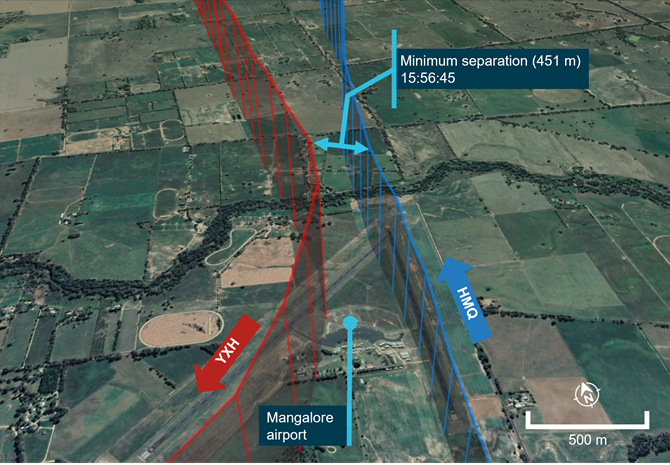The pilot of an AW139 emergency medical service helicopter received a TCAS ‘resolution advisory’ collision alert while transiting airspace above Mangalore Airport en route to Royal Melbourne Hospital when a Piper Seminole aircraft conducted an unanticipated missed approach to the airport, an ATSB investigation report details.

The report details that on the afternoon of June 6, 2021, as the Seminole aircraft tracked north along the RNAV-Z runway 36 approach to Mangalore, the AW139 helicopter was about 10 NM north of Mangalore and tracking south to overfly the airport at 3,100 ft. At about 1555, the Seminole commenced a missed approach resulting in the helicopter’s TCAS (traffic alerting and collision avoidance system) displaying a traffic advisory, followed by a resolution advisory.
Six seconds later, the aircraft passed in cloud 451 m (in a straight line) from each other with a minimum vertical separation of 543 ft and a minimum horizontal separation of 333 m. Both aircraft were in cloud throughout the occurrence.
“The ATSB’s investigation into this occurrence found that while the helicopter pilot was aware of the Seminole, they did not consider the possibility of the Seminole conducting a missed approach, which might conflict with the helicopter’s flight path,” said ATSB Director Transport Safety Stuart Macleod.
“The Seminole’s pilot, meanwhile, reported not hearing broadcasts from the helicopter and misinterpreted traffic advice from air traffic control, and consequently was not aware of the helicopter nearby and that an incident had occurred.”
The ATSB also found that the helicopter operator’s traffic alert and collision avoidance knowledge was inadequate with respect to resolution advisory alert terrain considerations and the required intensity of response manoeuvring.
“As such, this incident highlights the importance of effective flight crew TCAS training,” Mr. Macleod said.
“TCAS is a complex system which serves as a ‘last line of defence’ in airborne collision avoidance. Thorough knowledge of the system is critical in ensuring that crews respond appropriately to TCAS resolution advisories.”
The Seminole was not equipped with with TCAS or Automatic Dependent Surveillance Broadcast (ADS-B) IN (nor was it required to be), the report notes.
“The ATSB stresses that in non-controlled airspace the effective use of radio remains a primary defense in avoiding mid‑air collisions, achieved by maintaining an effective listening watch and proactive communication,” Mr Macleod said.
“In addition, the ATSB strongly encourages equipping all aircraft with ADS‑B transmitting, receiving and display devices as they can significantly assist pilots in identifying and avoiding conflicting traffic.
“The continuous positional information ADS‑B provides can predict a developing situation many minutes before it becomes hazardous – a significant improvement on both point‑in‑time radio traffic advice and ‘see‑and‑avoid’.”
Read the report AO-2021-023: Airborne collision alert involving AgustaWestland AW139, VH-YXH and Piper PA-44-180, VH-HMQ Mangalore Airport, Victoria on 6 June 2021
This press release was prepared and distributed by the Australian Transport Safety Bureau.








